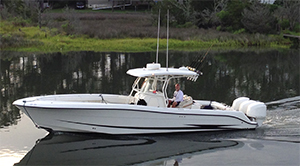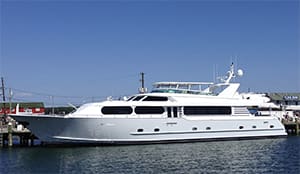For its captain and crew, life aboard a super yacht is filled with far less drama and romance than you might expect from watching a TV reality show such as the Bravo Network program “Below Decks.” This is especially true when the yacht is exclusively owner-used and not chartered like the 106-foot super yacht Illiquid, which is captained by Steve Steinberg and home-ported in Ft. Lauderdale.
I recently rode aboard Illiquid on an offshore trip from Greenport, N.Y., to Bermuda. The difference between power voyaging on a big yacht like Illiquid and sailing was brought home to me on that passage.
And while the trip might seem easier to the passengers and crew, make no mistake: The job of captain on a vessel like this requires considerable knowledge and know-how. Steinberg requires the executive abilities of a CEO of a good-sized company, the diplomatic sensitivity of a labor negotiator, an understanding of complex mechanical systems and the ability to repair them and, most importantly, the necessary maritime skills to safely guide the ship over open water.
Power captain with a sailor’s heart
The owners of Illiquid are fortunate to have found such a person in Captain Steinberg, a 45-year-old master mariner who maintains Illiquid in a state of continual readiness so that the owners can cruise aboard at a moment’s notice. Steinberg, a California native, has been on boats since childhood and made a bit of a local reputation as a high-line charter fishing boat captain. He understands boats well enough to have designed and implemented many changes into Illiquid that have added value to the vessel. He holds a 500-ton license and, though master of such a large motor vessel, is probably at heart a sailor, who proved his mettle competing in the 2000 Singlehanded TransPac race from California to Hawaii aboard an Olson 30. Of the difference, he says, “Sailing is about the process of getting there and power boats are about the destinations.”
As captain, Steinberg has a delicate balancing act. He is master of the ship but also has to anticipate and accommodate the needs of his employers. Such a job requires both tact and great skill, on the personal level and in his ability to decipher any mechanical problems and be prepared to fix them. He is a hands-on skipper who is as perfectly at home in the engine room as he is on the bridge. He really has two jobs, he says. One is maintaining the boat and the other is managing a five-star hotel. “Ninety percent of the time is spent maintaining the ship. When the guests come aboard, we turn into a hotel.”
For the past four and a half years, he has been in charge aboard the Broward-built Illiquid. Constructed of aluminum, the yacht has a 20-foot beam, a 6-foot 4-inch draft, displaces 163 tons and was built in 2005. The vessel is powered by two 1,550-hp Caterpillar C-30 twin turbos. Fuel consumption at 13 knots is 54 gallons an hour on flat water. Fresh water is supplied by a primary water tank of 1,200 gallons and the reverse osmosis system produces another 50 gallons of fresh water an hour. The vessel has three steering stations and is equipped with three Furuno GPS units that operate with Nobletec Time Zero software. There is a chartplotter, a 48-mile Furuno radar, a Simrad AP50 autopilot connected to the hydraulic steering system, driven by a 240-volt Jastram steering system. The vessel is equipped with one fluxgate auto-corrected compass and two magnetic compasses.
Generators and stabilizers
Electrical power is supplied by two 40-kW Westerbeke generators, but only one is run at a time. The boat is kept cool with a chilled-water air conditioning system that is ducted throughout the vessel. Stability at sea is provided by Naiad fin stabilizers and docking is made more efficient with the assistance of a 50-hp hydraulic bow thruster. The engine room is as clean and dust-free as the owners’ cabin.
 |
|
Illiquid’s 33-foot center console “dinghy.” |
Illiquid is hauled annually, with about a two-week yard period and two coats — or about 30 gallons — of bottom paint are needed to protect the bottom. It is a USCG-documented vessel with berthing for 14. Sanitary facilities include six showers and seven heads. There are four guest staterooms, three crew staterooms aft and two 40-gallon domestic hot-water heaters. The “dinghy” is a 33-foot Hydra-Sports center console, powered by three Yamaha F250 four-stroke engines. Instead of being stored on deck the tender is towed behind the vessel while underway with two 70-foot, 1.5-inch nylon lines. The dinghy weighs 13,000 pounds and has a fully fueled range of 300 miles at 28 knots.
Illiquid winters in the Caribbean and summers in the Northeast, steaming from 2,500 to 5,000 miles annually. Fuel capacity is 10,000 gallons held in four tanks. The waste oil tank is 150 gallons and the fresh oil tank is 150 gallons.
For entertainment the vessel is equipped with DirecTV and has a KVH satphone system.
Illiquid carries paper charts as backup, but the primary plot is run on a Nobletec system. They have charts for Central America and the Caribbean as far south as Trinidad. It’s a full-planing hull with a dead rise aft. When making 22 knots, the boat consumes 150 gallons per hour.
“Any time we plan a passage, it’s always about the weather,” said Steinberg. “We don’t run the boat in rough water (larger than 6-foot seas) and headwinds more than 20 knots — or when the wind is astern at 30 knots. For any offshore passage, we use Commanders’ Weather Routing Service out of New Hampshire. The vessel is always maintained in a state of readiness and with all vessels the biggest variable is the weather.”
“System maintenance is based on a zero failure rate.” Money is not usually an issue. “We are not cheap, but we are always frugal.”
Contributing editor David Berson writes the nav problem for each issue of Ocean Navigator and lives in Greenport, N.Y. where he co-owns and operates the electric vessel Glory.

